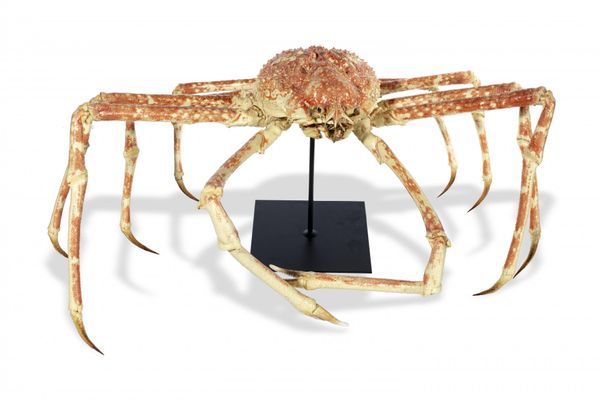(Macrocheira kaempheri ) subadult
mounted on stand
Origin: Trawled at 450 m. West off Mihama Point, Izu Peninsula, Shizuoka, Suruga Bay, Japan, from commercial fisheries (2019)
50cm high by 100cm wide by 60cm deep
| Estimate: | £3,000 - £5,000 |
C. J. Temminck described the species Maja kaempferi from specimens received from Philipp Franz von Siebold in 1836 which originated from Deshima island (= protruding island – jap. trans.) in the Nagasaki Bay. The specimens were one of the first that were available for European researchers and admirers. One of those specimens, now held in Naturalis presumably, was a giant male with a leg span of about 3 m (measured over the first pair of legs). The few specimens were obtained by von Siebold on one of his expeditions to the Japanese Islands and were carefully shipped back to Holland. This is the start of mankind’s fascination for the largest of all crabs in the world.
Originally described in the genus Maja but later placed in Macrocheira (= largely or over-constructed (latin trans.) Very little is known about these aquatic giants and even the figures about their maximum are sometime contradicting. Some sources speak of a leg span of over 4 m, others even 6 m. In collections, a leg span of 3 m is available (measured over the first pair of legs). As the size of the first pair of legs is not in direct relation with the size of the animal but with the age, the size is in modern times indicated measured over the second pair of legs which is more accurate and desired for size/weight comparison. The live at large depths of usually about 100-300 m but occasionally they are spotted by divers in the shallow subtidal zone. Reports of catches deeper than 350 m are probably because in their range deep sea fishing is rarely endeavored. Historically their range was believed to be the waters all along SE Japan, which is currently their main habitat. Today, almost all fishery of the crab is concentrated in or near Suruga Bay where it is locally consumed or kept for aquariums worldwide. For Both these markets they are in high demand. The meat is considered a true delicacy. Reports document the species occurrence also in the southern Kuril Islands and even around Taiwan. Due to the intensive fishing around their habitat, their numbers have gone down over the decades. Reports of fishermen having to go fish in more deeper areas every year are abundant. The monsters of a century ago have become rare. The average large size nowadays is about 1.0-1.2 m leg span. Reports of giants (3 m) being caught are only a handful a year.
The legend surrounding these majestic creatures is well known in Japanese folklore. The story goes that the large-legged giants were seen devouring the corpse of a drowned sailor. Other reports tell the story of the crabs hiding in the kelp forest waiting to strike. It is told that they could grasp a diving ama and drowning their victim by keeping them submerged until they would stop breathing only to feast on the decaying body, hence their folkloristic name “shinin-gani” or “dead man’s crab”. The first story could well have a true basis as these animals are scavengers. On the other hand, the second story is highly unlikely. The tale probably survived time because an underwater encounter with a male giant amongst the kelp is truly memorable, startling and perhaps even frightening. In their natural life, they rarely encounter humans as they normally live at great depths. Moreover, and in spite of their sheer size, these animals are very brittle. Legs are easily snapped of and hence complete specimens are rare. 99% of the caught specimens have 1 to 3 broken or missing legs. 4 is rarely observed. Any more loss leaves the animal incapable of survival.
In 1938, Orson Wells told the story of “War of the Worlds” by H. G. Wells on a popular US radio show which created that same night and following days chaos in the country. The story was adapted later for film in 1953. The robotic stalk-legged machines that invaded the earth were memorable by design. The design is said to have been copied from the natural design of a Japanese Giant Spider Crab. The resemblance is indeed truly striking.
Natural History, Taxidermy
© 2021 All rights reserved.

